Semicupolas

Cupolas only exist with
an n/d-gon as its n-face where n and d are co-prime and d is odd.
If we relax this latter condition we can consider n/d co-prime and d even.
The 2n-face, being a 2n/d-gon has both 2n and d even. This
makes it a degenerate polygon which is equivalent to wrapping an n/(d/2)-gon
twice around its centre.
The square and triangular
faces attach to each edge of this 2n/d-gon. As the edges of
this polygon are co-incident in pairs then these edges can be removed leaving
the square edge coincident with one and the triangular edge co-incident
with the other. This generates the family of semicupolas1
(also previously known as 'cuploids'). A simple example is the 5/2-semicupola above where the
pentagram is initially connected by a cupola type band of squares and triangles
to a pentagon.
Bounds of 6/5 < n/d < 6 again
apply, and again n and d must be co-prime, d must be even.
All of the semicupolas have the property
in that if n/d > 2 then the triangular and square faces do not totally
cover the 'underside' of the n-base. A small n-gonal 'membrane'
is left. The 5/2-semicupola has this property and with
11 faces may be the least faced polyhedron to contain a membrane. With
n/d
< 2 (e.g. the 5/4 semicupola then the underside
of the small base is completely covered.
This image of a 5/4-semicupola
(left) and 5/2-semicupola (right) was produced by Christine
Tuveson (ctuveson@earthlink.net)
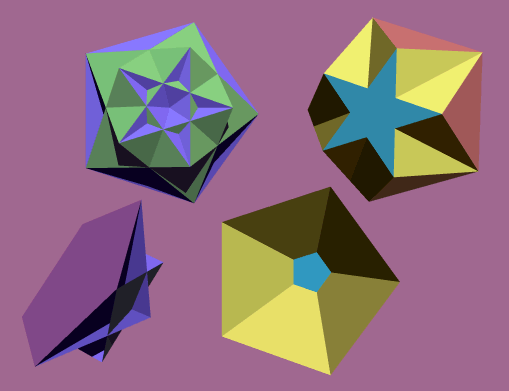
Image reproduced by permission
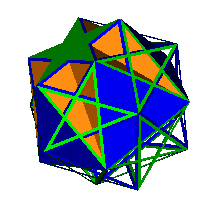
The 5/2
semicupola and 5/4 semicupola share faces with the
ditrigonal polyhedra. More on this relationship can be found here.
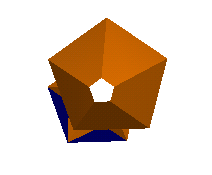
Any two n/d semicupolas may be
joined by their n/d faces to form a toiroidal figure, an interesting
case appears to be two 5/2 cuploids being joined
by their pentagrams to form the 5/2-semicupola toroid shown above.
The 7/4-semicupola has received some specific attention.
Firstly, the beautiful image below of a 7/4 semicupola
and its reflection was created by Christine Tuveson (ctuveson@earthlink.net).
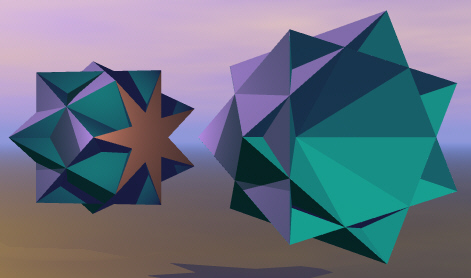
Image reproduced by permission
Secondly, the image below is of a physical
model (possibly the only physical model of a cuploid in existance) created
by Ulrich Mikloweit (polyart@citylink.de). His wonderful models are
unique in that he incorporates every part of each polygonal face, including
the internal facets. More images of the cuploid and of Ulrich's many
other models can be found on his website at http://www.polyedergarten.de
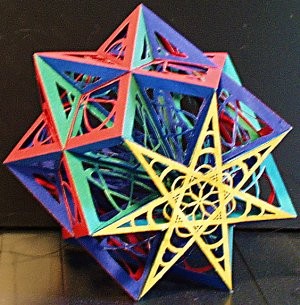
Image reproduced by permission
A second form can be generated by merging two
cupolas. Superpose both the n-face and 2n-faces. Then rotate
one cupola by 2pi/2n such that the vertices of the 2n-faces are again superposed.
The n-faces will will be gyrated with respect to each other. These
composite polyhedra is termed a sesquicupola1 (also previously known
as a "blended gyro bicupola"). The term
"blended" is required to distinguish these solids from the gyro bicupolas
where the small faces are not superposed. For example, the blended
3/1 gyro bicupola is shown below, whilst the 3/1
gyro bicupola is more commonly known as the cuboctahedron.
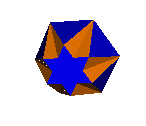
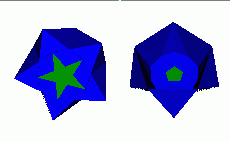
Finally, and without any particular
rationale other than forming an interesting model, for the 5/2-semicupola,
it can be augmented by replacing the square faces
with square pyramids to generate the strange
looking almost shell like figure above.
Footnote
1. the terms 'semicupola' and 'sesquicupola' were introduced by Dr Norman
Johnson in a private communication dated December 2004.
Next: The 5/2
semicupola, the 5/4 semicupola and the ditrigonal polyhedra
Back: To Cupolas
Back: To Index







